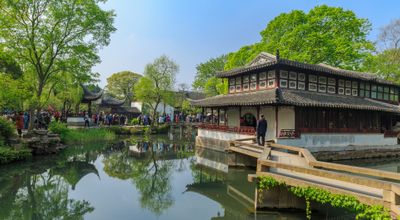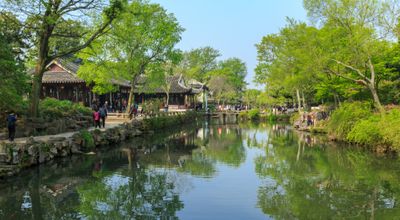You can take public buses or dedicated tourist shuttles going to the Beiyuanlu or Suzhou Museum stations that are close to the attraction. From April to October (except the month of June) the admission price is RMB90 while the rest of the year it is RMB70. Kids are allowed free entry if they measure under 4.6 feet and are accompanied by an elder. The timings are from 07:30 to 17:00. There are a couple of exhibitions that are held here, like the Azalea show and Lotus show from April to October so maybe plan to catch those. It is a popular local attraction and is mostly crowded. Early mornings on working days are perhaps the most peaceful times to visit.
Originally built in 1509, the garden changed ownership many times and was even divided up into three parts at one point until, in 1949 the Government took it back and reunified the original 13 acres once more. This is the reason for the three sections that exist today in the garden and represent different styles of décor, though they come together harmoniously and elegantly. Three-fifth of the area is covered in water and the place has a tasteful sprinkling of pavilions, different breed of plants, mini islands, halls, hills, rock décor, flora, pools and passageways.
The Central Section, covering the most area, is most typical of the Ming era characteristics from the inception of the place. The Drifting Fragrance Hall is the star of the area; a square hall with full-length decorative glass panes that overlook a lotus populated pond on one side and a bamboo groove and rock décor shading the pond on the other. When the lotuses mature, they provide the faint scent for which the building is named. Other attractions are ‘Hear the Rain’ Pavilion, Exquisite Hall, Loquat Garden, Lotus Wind Pavilion and Jiashi Pavilion.
Moving to the East Section, the style will change to a more recent theme as the building here are the last to be constructed. It has all the mainstay elements of bridges, verandas and artificial hills dotted with willow trees and Chinese ash but there is also a break from that in the form of a sophisticated tea house named Shuxiang Hall.
In the end, you come upon the West Section, which is more in sync with Qing dynastic horticultural style, though the main theme is still centered on dominant water scenery with rock formations. The Yushuitongzuo Pavilion (aka ‘With Whom Shall I Sit’) and 36 Yuanyang Hall (36 Mandarin Duck) are the notable buildings here that provide the most exquisite views.
Nearby Metro Stations
The following metro stations are within 2km of this attraction:








